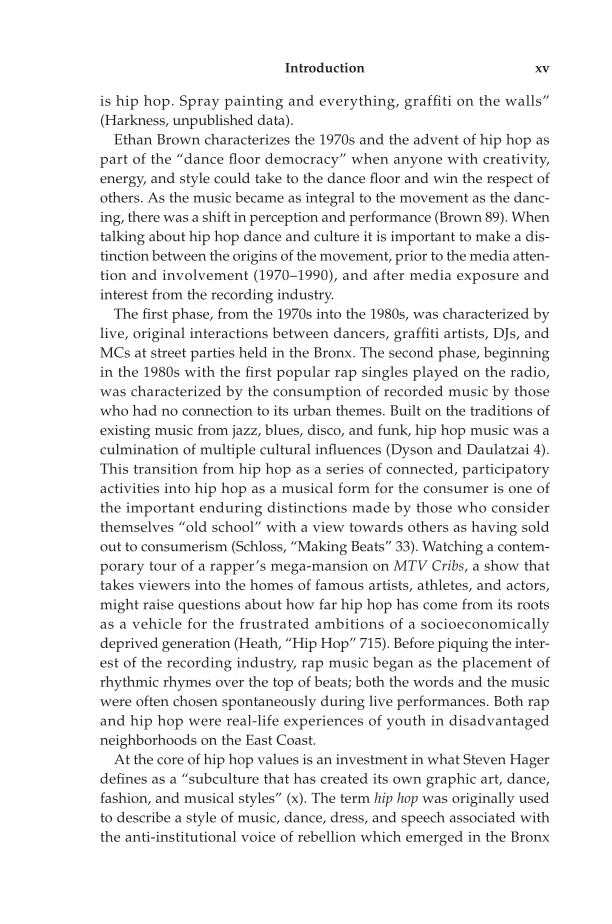is hip hop. Spray painting and everything, graffiti on the walls” (Harkness, unpublished data). Ethan Brown characterizes the 1970s and the advent of hip hop as part of the “dance floor democracy” when anyone with creativity, energy, and style could take to the dance floor and win the respect of others. As the music became as integral to the movement as the danc- ing, there was a shift in perception and performance (Brown 89). When talking about hip hop dance and culture it is important to make a dis- tinction between the origins of the movement, prior to the media atten- tion and involvement (1970–1990), and after media exposure and interest from the recording industry. The first phase, from the 1970s into the 1980s, was characterized by live, original interactions between dancers, graffiti artists, DJs, and MCs at street parties held in the Bronx. The second phase, beginning in the 1980s with the first popular rap singles played on the radio, was characterized by the consumption of recorded music by those who had no connection to its urban themes. Built on the traditions of existing music from jazz, blues, disco, and funk, hip hop music was a culmination of multiple cultural influences (Dyson and Daulatzai 4). This transition from hip hop as a series of connected, participatory activities into hip hop as a musical form for the consumer is one of the important enduring distinctions made by those who consider themselves “old school” with a view towards others as having sold out to consumerism (Schloss, “Making Beats” 33). Watching a contem- porary tour of a rapper’s mega-mansion on MTV Cribs, a show that takes viewers into the homes of famous artists, athletes, and actors, might raise questions about how far hip hop has come from its roots as a vehicle for the frustrated ambitions of a socioeconomically deprived generation (Heath, “Hip Hop” 715). Before piquing the inter- est of the recording industry, rap music began as the placement of rhythmic rhymes over the top of beats both the words and the music were often chosen spontaneously during live performances. Both rap and hip hop were real-life experiences of youth in disadvantaged neighborhoods on the East Coast. At the core of hip hop values is an investment in what Steven Hager defines as a “subculture that has created its own graphic art, dance, fashion, and musical styles” (x). The term hip hop was originally used to describe a style of music, dance, dress, and speech associated with the anti-institutional voice of rebellion which emerged in the Bronx Introduction xv
Document Details My Account Print multiple pages
Print
You have printed 0 times in the last 24 hours.
Your print count will reset on at .
You may print 0 more time(s) before then.
You may print a maximum of 0 pages at a time.

































































































































































